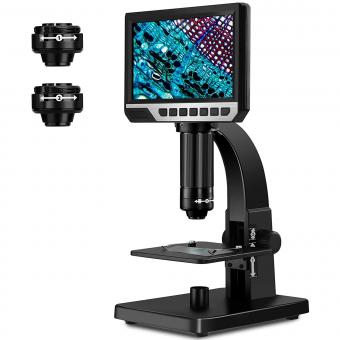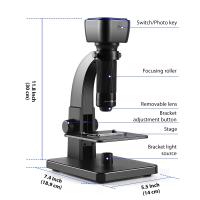What Are Confocal Microscopes Used For ?
Confocal microscopes are used for high-resolution imaging and analysis of biological samples. They are commonly used in various fields of research, including cell biology, neuroscience, and materials science. The main advantage of confocal microscopy is its ability to eliminate out-of-focus light, resulting in improved image quality and increased optical sectioning. This allows researchers to visualize and study the three-dimensional structure of cells and tissues with exceptional clarity. Confocal microscopes are particularly useful for studying dynamic processes in living cells, as they can capture images in real-time and at different depths within the sample. Additionally, confocal microscopy can be combined with other techniques such as fluorescence labeling and spectral imaging to provide further insights into cellular structures and functions.
1、 High-resolution imaging of biological samples with optical sectioning capability.
Confocal microscopes are advanced imaging tools used in various scientific fields, particularly in biology and biomedical research. They offer high-resolution imaging of biological samples with optical sectioning capability, allowing researchers to visualize and analyze samples in three dimensions.
The optical sectioning capability of confocal microscopes is achieved by using a pinhole aperture to eliminate out-of-focus light, resulting in sharper and clearer images. This enables researchers to study the fine details of biological samples, such as cells, tissues, and even subcellular structures, with exceptional clarity and precision.
Confocal microscopy has revolutionized the field of cell biology by providing a non-invasive method to study living cells in real-time. It allows researchers to track dynamic processes within cells, such as cell division, protein trafficking, and cellular signaling, with high temporal and spatial resolution. This has led to significant advancements in our understanding of cellular mechanisms and disease processes.
Moreover, confocal microscopes are widely used in neuroscience research to study the intricate structure and function of the brain. They enable researchers to visualize neuronal connections, study synaptic activity, and investigate the dynamics of neural circuits. This has contributed to our understanding of brain development, neurodegenerative diseases, and the effects of drugs on the nervous system.
In recent years, confocal microscopy has also been combined with other techniques, such as fluorescence labeling and super-resolution imaging, to further enhance its capabilities. This has allowed researchers to study molecular interactions, protein localization, and cellular dynamics at an unprecedented level of detail.
Overall, confocal microscopes are indispensable tools in biological research, providing high-resolution imaging and optical sectioning capabilities that have greatly advanced our understanding of the complex world of biology.
2、 Analysis of fluorescently labeled specimens with minimal background noise.
Confocal microscopes are used for the analysis of fluorescently labeled specimens with minimal background noise. These microscopes are widely used in various fields of research, including biology, medicine, and materials science.
One of the key advantages of confocal microscopy is its ability to eliminate out-of-focus light, resulting in improved image quality and resolution. This is achieved through the use of a pinhole aperture, which allows only the light emitted from the focal plane to reach the detector. By scanning the specimen point by point, a three-dimensional image can be reconstructed, providing detailed information about the specimen's structure and composition.
Confocal microscopy is particularly useful for studying fluorescently labeled specimens because it allows researchers to visualize specific molecules or structures within a sample. Fluorescent labels can be attached to specific proteins, DNA, or other molecules of interest, enabling researchers to track their location, movement, and interactions in real-time. This is crucial for understanding various biological processes, such as cell signaling, protein localization, and gene expression.
Moreover, confocal microscopy enables the examination of thick specimens, such as tissue sections or whole organisms, without the need for physical sectioning. This non-destructive imaging technique is especially valuable in medical research, where it allows for the visualization of cellular and subcellular structures in intact tissues.
In recent years, confocal microscopy has been further enhanced with advanced imaging techniques, such as fluorescence lifetime imaging (FLIM) and fluorescence correlation spectroscopy (FCS). FLIM provides information about the fluorescence decay rate, which can be used to study molecular interactions and protein dynamics. FCS, on the other hand, measures the fluctuations in fluorescence intensity, allowing for the quantification of molecular diffusion and binding kinetics.
Overall, confocal microscopes are indispensable tools for the analysis of fluorescently labeled specimens, providing researchers with high-resolution images and valuable insights into the intricate workings of biological systems.
3、 Examination of live cells and tissues in real-time.
Confocal microscopes are advanced imaging tools used in various scientific fields, particularly in biology and medicine. They are primarily used for the examination of live cells and tissues in real-time.
Confocal microscopy allows researchers to obtain high-resolution images of biological samples with exceptional clarity and detail. The technique works by using a laser to illuminate a specific plane within the sample, while a pinhole aperture blocks out-of-focus light from reaching the detector. This enables the microscope to capture sharp images of thin optical sections, resulting in improved contrast and resolution compared to conventional microscopy.
The ability to examine live cells and tissues in real-time is one of the key advantages of confocal microscopy. Researchers can observe dynamic processes such as cell division, migration, and interaction with other cells or molecules. This real-time imaging capability provides valuable insights into the behavior and function of cells and tissues, helping to advance our understanding of various biological processes.
In recent years, confocal microscopy has also been used in the field of neuroscience to study the structure and function of the brain. By labeling specific neuronal structures or using fluorescent markers, researchers can visualize and track individual neurons in real-time, allowing for the investigation of neural circuits and the dynamics of neuronal activity.
Furthermore, confocal microscopy has found applications in the study of cancer biology, immunology, developmental biology, and many other areas of research. It has become an indispensable tool for scientists seeking to unravel the complexities of biological systems and gain a deeper understanding of the fundamental processes that govern life.
In conclusion, confocal microscopes are used for the examination of live cells and tissues in real-time. Their high-resolution imaging capabilities and ability to capture dynamic processes have revolutionized various scientific fields, enabling researchers to explore the intricate details of biological systems and uncover new insights into the workings of life.
4、 Investigation of subcellular structures and organelles.
Confocal microscopes are advanced imaging tools used in various fields of research, including biology, medicine, and materials science. They are primarily used for the investigation of subcellular structures and organelles within cells.
One of the key advantages of confocal microscopy is its ability to provide high-resolution, three-dimensional images of biological samples. By using a laser to scan the sample point by point, confocal microscopes eliminate out-of-focus light, resulting in sharper images with improved contrast and clarity. This allows researchers to study the intricate details of subcellular structures and organelles, such as the nucleus, mitochondria, endoplasmic reticulum, and Golgi apparatus.
Confocal microscopy has revolutionized the field of cell biology by enabling researchers to visualize dynamic processes within living cells. It has been instrumental in studying cellular processes like cell division, protein trafficking, and organelle dynamics. Additionally, confocal microscopy has been used to investigate the localization and interactions of specific molecules within cells, providing insights into cellular signaling pathways and molecular mechanisms.
In recent years, confocal microscopy has also been combined with other techniques to enhance its capabilities. For example, the integration of fluorescence resonance energy transfer (FRET) allows researchers to study protein-protein interactions and molecular dynamics in real-time. Furthermore, the development of super-resolution techniques, such as stimulated emission depletion (STED) microscopy and structured illumination microscopy (SIM), has pushed the boundaries of confocal microscopy, enabling the visualization of structures at the nanoscale level.
Overall, confocal microscopes have become indispensable tools for studying subcellular structures and organelles, providing valuable insights into the complex world of cells and their functions. With ongoing advancements in technology, confocal microscopy continues to evolve, offering new possibilities for understanding cellular processes and advancing scientific knowledge.




























There are no comments for this blog.